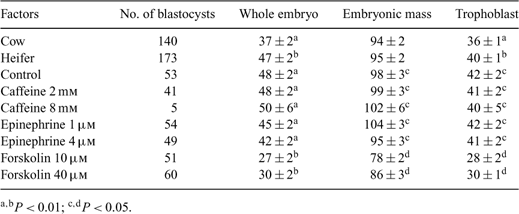109 EFFECTS OF LIPOLYTIC AGENTS FORSKOLIN, EPINEPHRINE AND CAFFEINE ON EMBRYONIC DEVELOPMENT AND LIPID CONTENT OF BOVINE EMBRYOS PRODUCED IN VITRO
M. Barcelo-Fimbres A and G. E. Seidel AColorado State University, Fort Collins, CO, USA
Reproduction, Fertility and Development 21(1) 154-155 https://doi.org/10.1071/RDv21n1Ab109
Published: 9 December 2008
Abstract
The objective of this experiment was to evaluate lipid accumulation and embryonic development of bovine morulae treated with different chemicals. A total of 2619 slaughterhouse oocytes from heifers and mature cows were matured in CDM medium (similar to SOF) plus 0.5% fatty acid-free BSA and hormones (M-CDM) for 23 h at 38.5°C in 5% CO2 in air. Frozen–thawed sperm were centrifuged through a Percoll gradient and co-cultured with matured oocytes for 18 h in F-CDM (CDM+heparin). Zygotes were cultured at 38.5°C in 5% CO2/5% O2/90% N2 in CDM-1 with nonessential amino acids, 10 μm EDTA, 0.5% fatty acid free BSA, and 0.5 mm fructose. After 60 h, resulting 8-cell embryos were cultured 120 h in CDM-2 (CDM-1+essential amino acids and 2 mm fructose). A factorial design was used with 7 treatments, 2 ovary sources (cows v. heifers), and 3 bulls (A, B and C) replicated twice for each bull (6 replicates). At Day 2.5 embryo cleavage and 8-cell rates were evaluated, and on Day 6 a total of 755 morulae were randomly assigned to the 7 treatments (control, 2 and 8 mm caffeine, 1 and 4 μm epinephrine, and 10 and 40 μm forskolin). To quantify lipid accumulation, Day 7 blastocysts were fixed and stained with 1 μg mL–1 Nile red dye, after which a digital photograph of the equatorial part of the embryo (including the inner cell mass) was taken at 200×, and fluorescence intensity was measured with Image Pro software from 0 to 255 shades for each pixel (0 = no lipids; 255 = greatest lipid accumulation), as previously reported (Biol. Reprod. 2007 (Suppl. 1), 87–88). Data were analyzed by ANOVA. No differences in cleavage rates (75 v. 68 ± 3.6%) or eight cell rates (61 ± v. 57 ± 2.8%) were found for heifer v. cow oocytes (P > 0.1); however, blastocyst rates per oocyte and per 8-cell embryo were greater for cows than heifers (20 v. 10 ± 2.1%, and 68 v. 35 ± 3.8%, respectively; P < 0.05). Treatments: 2 and 8 mm caffeine produced fewer blastocysts per morula than 1 and 4 μm epinephrine, 10 and 40 μm forskolin and the control (39, 5 v. 54, 49, 48, 54 and 52 ± 5.8%; respectively) (P < 0.01). More lipid content was found in whole embryos and trophoblast of heifer-derived than cow blastocysts (P < 0.05), and forskolin resulted in less lipid content than control, caffeine- and epinephrine-treated morulae in whole embryos, embryonic mass and trophoblasts (P < 0.05; Table 1). In conclusion, mature cows were a better source of oocytes than feedlot heifers for embryonic development. High doses of caffeine were detrimental to embryos, and the addition of the lypolitic agent forskolin reduced lipid content relative to control, caffeine and epinephrine-treated embryos.

|


